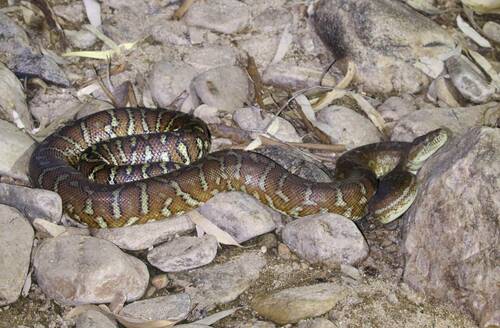
Centralian Carpet Python
Bredl's Python, a striking reddish-brown snake, thrives in Australia's arid heart. Known for its gentle demeanor, this nocturnal hunter expertly navigates rocky terrains, preying on small mammals and birds. Its presence is vital for maintaining ecological balance through natural pest control. A true desert jewel in the python family.
Length: 1.8288 - 2.5908 m
Size
Brown, Red, White, Cream
Color
Low
Aggression
Least Concern
Conservation Status
Stable
Population Trend
Characteristics
Morelia bredli, commonly known as Bredl's Python, is a non-venomous snake native to the arid regions of central Australia. It is characterized by its reddish-brown coloration with darker crossbands, a robust body, and a typical length of 6-8 feet. This python is known for its docile nature and nocturnal hunting habits, primarily preying on small mammals and birds. Bredl's Pythons play a crucial role in controlling the populations of their prey within their ecosystem.
Distribution Range of the Centralian Carpet Python
Morelia bredli, commonly known as Bredl's python or the Centralian python, is native to Australia. Its geographical distribution is primarily restricted to the central region of the Northern Territory, particularly around the MacDonnell Ranges.
Centralian Carpet Python's Habitat
Environmental Conditions
Bredl's python inhabits semi-arid to arid environments typical of central Australia. These regions experience extreme temperature variations, with hot days and cold nights. The climate is characterized by low annual rainfall, contributing to a dry and sparse landscape.
Ecological Niche
Morelia bredli is typically found in rocky outcrops, gorges, and open woodlands. The python utilizes the rocky terrain for shelter and thermoregulation, often hiding in crevices during the heat of the day and becoming more active during cooler periods. This species is well-adapted to its arid environment, feeding on small mammals and birds that inhabit the same ecological niche. Its coloration provides excellent camouflage against the red and brown hues of the Australian outback.
Copyright @ Nature Style Limited. All Rights Reserved.
 English
English